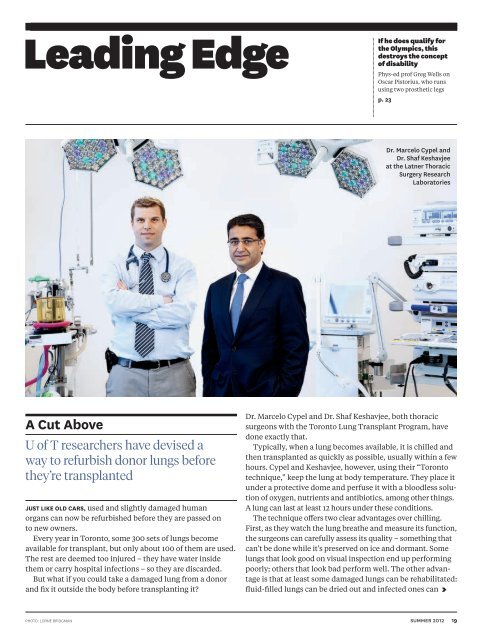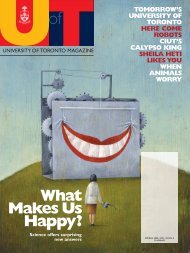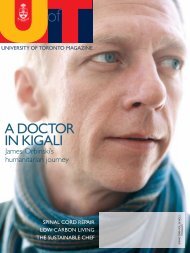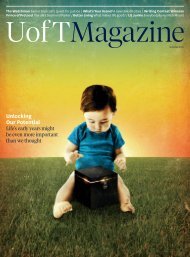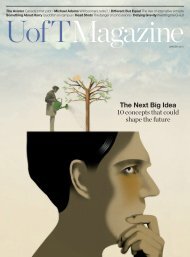What's the solution to Toronto's traffic problems? - University of ...
What's the solution to Toronto's traffic problems? - University of ...
What's the solution to Toronto's traffic problems? - University of ...
You also want an ePaper? Increase the reach of your titles
YUMPU automatically turns print PDFs into web optimized ePapers that Google loves.
Leading Edge<br />
If he does qualify for<br />
<strong>the</strong> Olympics, this<br />
destroys <strong>the</strong> concept<br />
<strong>of</strong> disability<br />
Phys-ed pr<strong>of</strong> Greg Wells on<br />
Oscar Pis<strong>to</strong>rius, who runs<br />
using two pros<strong>the</strong>tic legs<br />
p. 23<br />
Dr. Marcelo Cypel and<br />
Dr. Shaf Keshavjee<br />
at <strong>the</strong> Latner Thoracic<br />
Surgery Research<br />
Labora<strong>to</strong>ries<br />
A Cut Above<br />
U <strong>of</strong> T researchers have devised a<br />
way <strong>to</strong> refurbish donor lungs before<br />
<strong>the</strong>y’re transplanted<br />
JUST LIKE OLD CARS, used and slightly damaged human<br />
organs can now be refurbished before <strong>the</strong>y are passed on<br />
<strong>to</strong> new owners.<br />
Every year in Toron<strong>to</strong>, some 300 sets <strong>of</strong> lungs become<br />
available for transplant, but only about 100 <strong>of</strong> <strong>the</strong>m are used.<br />
The rest are deemed <strong>to</strong>o injured – <strong>the</strong>y have water inside<br />
<strong>the</strong>m or carry hospital infections – so <strong>the</strong>y are discarded.<br />
But what if you could take a damaged lung from a donor<br />
and fix it outside <strong>the</strong> body before transplanting it<br />
Dr. Marcelo Cypel and Dr. Shaf Keshavjee, both thoracic<br />
surgeons with <strong>the</strong> Toron<strong>to</strong> Lung Transplant Program, have<br />
done exactly that.<br />
Typically, when a lung becomes available, it is chilled and<br />
<strong>the</strong>n transplanted as quickly as possible, usually within a few<br />
hours. Cypel and Keshavjee, however, using <strong>the</strong>ir “Toron<strong>to</strong><br />
technique,” keep <strong>the</strong> lung at body temperature. They place it<br />
under a protective dome and perfuse it with a bloodless <strong>solution</strong><br />
<strong>of</strong> oxygen, nutrients and antibiotics, among o<strong>the</strong>r things.<br />
A lung can last at least 12 hours under <strong>the</strong>se conditions.<br />
The technique <strong>of</strong>fers two clear advantages over chilling.<br />
First, as <strong>the</strong>y watch <strong>the</strong> lung brea<strong>the</strong> and measure its function,<br />
<strong>the</strong> surgeons can carefully assess its quality – something that<br />
can’t be done while it’s preserved on ice and dormant. Some<br />
lungs that look good on visual inspection end up performing<br />
poorly; o<strong>the</strong>rs that look bad perform well. The o<strong>the</strong>r advantage<br />
is that at least some damaged lungs can be rehabilitated:<br />
fluid-filled lungs can be dried out and infected ones can<br />
PHOTO: LORNE BRIDGMAN summer 2012 19


